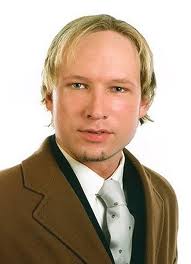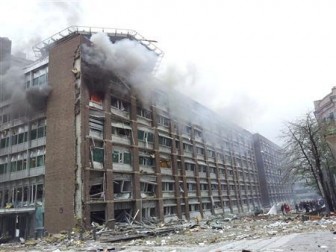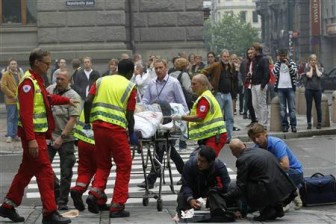OSLO, (Reuters) – A gunman dressed in police uniform opened fire at a youth camp of Norway’s ruling political party today, killing at least 80 people, hours after a bomb killed seven in the government district in the capital Oslo.
“The updated knowledge we are sitting on now is at least 80,” police chief Oystein Maeland told a news conference.

“We can’t guarantee that won’t increase somewhat,” he said.
Witnesses said the gunman, identified by police as a 32-year-old Norwegian, moved across the small, wooded Utoeya holiday island firing at random as young people scattered in fear. Norwegian television TV2 said the gunman, described as tall and blond, had links to right-wing extremism.
It was the biggest attack in Western Europe since the 2004 Madrid train bombings that killed 191.
“I just saw people jumping into the water, about 50 people swimming towards the shore. People were crying, shaking, they were terrified,” said Anita Lien, 42, who lives by Tyrifjord lake, a few hundred metres (yards) from Utoeya island, northwest of Oslo.
“They were so young, between 14 and 19 years old.”
Many sought shelter in buildings as shots echoed across the island, ran into the woods or tried to swim to safety. Boats searched for survivors into the night, searchlights sweeping the coast. Helicopters flew overhead.
Survivor Jorgen Benone, who was on the island at the time, said: “I saw people being shot. I tried to sit as quietly as possible. I was hiding behind some stones. I saw him once, just 20, 30 metres away from me. I thought ‘I’m terrified for my life’, I thought of all the people I love.”
Police seized the gunman, who they believed was also linked to the bombing, and later found undetonated explosives on the island, a pine-clad strip of land about 500 metres long, to the northwest of Oslo.
The bomb, which shook the city centre in mid-afternoon, blew out the windows of the prime minister’s building and damaged the finance and oil ministry buildings. Stoltenberg was not in the building at the time.
“People ran in panic,” said bystander Kjersti Vedun.
With police advising people to evacuate central Oslo, and some soldiers taking up positions on the streets, the usually sleepy capital was gripped by fear of fresh attacks. Streets were strewn with shattered masonry, glass and twisted steel.
“It is the most violent event to strike Norway since World War Two,” said Geir Bekkevold, an opposition parliamentarian for the Christian Peoples Party.
“I have a message to the one who attacked us and those who were behind this,” Prime Minister Stoltenberg said in a televised news conference. “No one will bomb us to silence, no one will shoot us to silence.”
He declined to speculate on who had been involved.
OKLAHOMA BOMBING
NUPI Senior Research Fellow Jakub Godzimirski said he suspected a right-winger, rather than any Islamist group. Right wing groups have grown up in Norway and elsewhere in northern Europe around the issue of immigration.
“It would be very odd for Islamists to have a local political angle. The attack on the Labour youth meeting suggests it’s something else. If Islamists wanted to attack, they could have set off a bomb in a nearby shopping mall rather than a remote island.”
Right-wing militancy has generated sporadic attacks in other countries, including the United States. In 1995, 168 people were killed when Timothy McVeigh detonated a truck bomb at a federal building in Oklahoma City.
Deputy Oslo police chief Sveining Sponheim told reporters that the gunman in the Utoeya shootings had been disguised in a blue police-style uniform but had never been a police officer.
Police searched a flat in west Oslo where the man lived, and evacuated some neighbours.
NATO member Norway has been the target of threats before over its involvement in conflicts in Afghanistan and Libya.
Violence or the threat of it has already come to the other Nordic states: a botched bomb attack took place in the Swedish capital Stockholm last December and the bomber was killed.
Denmark has received repeated threats after a newspaper published cartoons of the Prophet Mohammad in late 2005, angering Muslims worldwide.
In Oslo, the building of a publisher which recently put out a translation of a Danish book on the cartoon controversy was also affected, but was apparently not the target.
The Oslo district attacked is the very heart of power in Norway. Nevertheless, security is not tight in a country unused to such violence and better known for awarding the Nobel Peace Prize and mediating in conflicts, including the Middle East and Sri Lanka.


